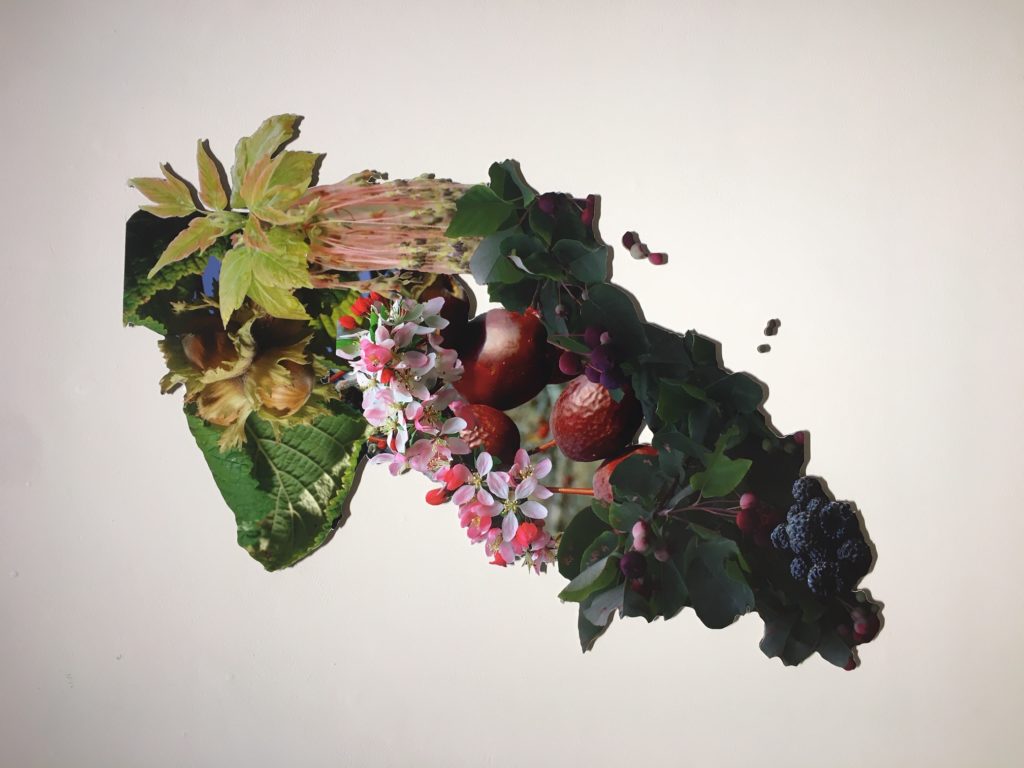Stephanie Lindquist exhibit explores our relation to our landscape and its flora

Lindquist created four photo collage works of native North Dakota plants specifically for the exhibition at the Memorial Union Gallery.
Today, artist Stephanie Lindquist can tell you about the edible parts of celosia and the movement of Africa’s grain coast from red to white rice, but it wasn’t always this way.
Stephanie Lindquist’s obsession with plants didn’t start until she was an undergraduate at Columbia University in New York, NY. While in Harlem, she lived in an old schoolhouse with a large front and backyard. The space was where she and her neighbors decided to start a garden.
This garden became her entry point to delve deeper into how the plants we consume are connected or disconnected to our landscape. Early on Lindquist was fascinated by farmer-philosopher Masanobu Fukuoka.
At the Jan. 28 reception, Lindquist acknowledged that Fukuoka’s five main principles of farming would go against basically any modern farmer. “He believed in no tilling of the soil, no fertilizers, including manure, no pesticides, no weeding and no pruning,” Lindquist explained.
She continued by saying that because these are the main things that most farmers do for their crops, Fukuoka was often referred to as the “do nothing farmer.” His ideas of eating ancient foods sparked her thinking about what it would mean for her to eat ancient.
Her exploration of plants turned toward the idea of food’s role in place. Her brief for “Site-ation” talks about how those of us who have settled on a new land have forgotten the natural foods and medicines that grow on the landscapes around us in favor of highly processed structures that remove our sense of place.
Lindquist admitted at the reception that she is mindful her relation to a place is not as deep as some, as her ancestors were also immigrants to the American landscape. However, she has made steps to get to know a place that she finds herself in by learning about and consuming its native plants.
She wants to form a relationship with the landscape through the process of growing, consuming and researching its natural food in the way that another of her inspirations, Oglala Lakota chef Sean Sherman suggests.
‘Site-ations’
In “Site-ations,” Lindquist took plants she had grown in her garden or were around her home and immortalized them in collagraph. Two struggling cornstalks dance in one large piece, while Bicolor Sorghum sweeps across in another.
While most of the plants in “Site-ations” were edible grains, a collagraph of a clump of crabgrass seemed to be a departure from that theme. Lindquist laughed and said she was aware that it was one of the “weird ones” in the exhibit. She explained she created the collagraph after she had moved to a new house and was trying to find a piece of the landscape around her.
‘Founded’
The “Founded” series by Lindquist focuses on the native plants of specific areas. The first installment of the series was focused on different areas of Africa. Specifically for the NDSU Memorial Union Gallery exhibit, however, Lindquist added four brightly colored collages of edible and medicinal plants found in North Dakota to the series.
Gallery Coordinator, Anthony Faris, commented that he had noticed exhibit visitors pointing out the different plants to each other and discussing them.
The bright colors and 2-Dimensional nature of the works were inspired by the corner stores of New York City. “I don’t know if you have these here, too, or not, but in New York, we have these corner stores where you can get sandwiches and snacks. These stores have these brightly-colored food posters in the window that tell you ‘this is what you can get to eat here,'” Lindquist said.
When researching North Dakota’s plants, Lindquist was inspired by Buffalo Bird Woman, also known as Waheenee, and her detailed account of her farming practices in North Dakota. Sean Sherman’s “The Sioux Chef’s Indigenous Kitchen” and “Native American Food Plants” by Daniel E. Moerman were also influential to her work.
‘Big Dibbler’
A large interactive piece, “Big Dibbler” is a contemporary take on a practical farming tool. A dibbler is often handmade and passed down through generations. It is a tool that is rolled across a garden plot, for example, and marks where to plant each seed so that they are equidistantly spaced.
Gallery visitors are encouraged to step on the circular patch of soil and push the dibbler around the circle. The gallery asks that you wipe your shoes on the mat next to the piece when you are finished interacting with the dibbler.
Lindquist’s work will be on display at the NDSU Memorial Union Gallery until Feb. 27. Admission is free.
